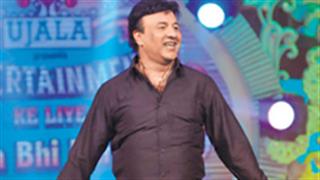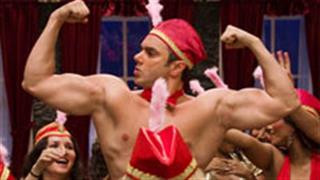Mirch your new film comes after a gap of 7 years. Why this prolonged abstinence from filmmaking?
The gap was not of my own volition. Few projects did not take off for one or the other reason. But, I am glad that I am back with MIRCH – a film after my own heart.
After the politics of politics in Godmother Mirch goes into the politics of sex. What made you go into this tantalizing subject?
The idea of Mirch came to me when I read the Panchtantra story way back in the mid- seventies; I was enthralled by the quality of its wit: if you have the presence of mind, you can solve seemingly the most unsolvable situation.
Also, the fact that the story was written more than 2000 years ago and dealt with the issue of adultery in such a non-judgemental manner exalted me about our pragmatic heritage.
Since I knew that the story cannot be stretched to 2 hours, I thought of collecting 4 such stories and put them together. Had I made the film then, it would have been considered very avant-garde. Wit and its narrative structure were the primary considerations for me to make this film. Saeed Mirza finds that the film has broken new ground in the art of story telling.
Ironically your protagonist Maanav is struggling against making compromised cinema. But we the audience watch your creativity projected into exactly the same stories that Maanav your protagonist thinks is compromised cinema. Is that a contradiction you are comfortable with?
The way these stories have been dealt with are in no way a compromise. In fact, restraint is what is being appreciated even by the most discerning audience. I will quote Aparna Sen here:"Mirch is a delightful and highly sophisticated film that I enjoyed thoroughly! The different time periods have been dealt with very intelligently."
Sex sells. Is that the premise which made you take up the theme?
 There are 2 premises on which the narrative of Mirch stands:
There are 2 premises on which the narrative of Mirch stands:Of the Maanav story it is, "How does a creative artiste find his creative freedom in today's mercantile world?"And of the 4 erotic stories it is, "If you have your wits about you, you can solve even the most unsolvable problem."
There are 4 extremely provocative and sexy stories in Mirch. What made you choose these stories?
These are erotic stories, and Eroticism is a valid art form. Humour, wit, and the clever twists in the end drew me to these stories.
Each one shows the wife to be treacherous and sexually unfaithful to her partner. Isn't that a very strong comment on female sexuality?
Barring the first story, which is an adaptation of the Panchtantra story (isn't it remarkable that Pt. Vishnu Dutt Sharma sees no reason to justify the wife's cuckoldry!), the female characters in all the other stories have reasons to behave the way they do.
In the 2nd story, the queen's husband is her grandfather's age, unable to satisfy her biological need (the story is taken from the Italian classic Decameron); in the 3rd story, the husband suspects his wife's character simply because she is physical in the demonstration of her love (men can be physical, but women cannot, seems to be his logic) and drives her to falter; and the 4th story has a couple who are both equally lascivious.
Each story has the woman protagonist spinning a cunning tale to cuckold her husband. What exactly are the stories trying to say about trust and fidelity/infidelity on a relationship.
These stories should not be viewed as morality tales, but from the perspective of wit and humour. The film's closing confrontation scene clearly states that men and women share an equal platform when it comes to the social and moral responsibility in a relationship.
Two stories are set in current times and the other two are costume dramas. Was that a formulistic format devised to keep the multiplexes happy?
The first story is placed in ancient times, while the 2nd story is placed in the medieval period; the 3rd and the 4th story take place in contemporary times.
For me it was the variation of the Panchtantra story that travels in time: if you observe closely, you will discover that the Panchtantra story does not use a single word that is derived from Persian, or Urdu – it is sanskritized Hindi; while the 2nd story uses Hindustani. The 3rd story uses Hinglish, and in the 4th story, it is creole: it is my comment on the degradation of the language.
 Similarly, how the living space has been shrinking through the times can be gauged in the way locations are used in the stories: in the 1st story, the couple lives amidst nature; in the 2nd story, there is heavy architectural grandeur; in the 3rd story, the couple is living in the compact space of a flat; while the 4th story takes place inside a hotel room (how we have lost contact with the nature).
Similarly, how the living space has been shrinking through the times can be gauged in the way locations are used in the stories: in the 1st story, the couple lives amidst nature; in the 2nd story, there is heavy architectural grandeur; in the 3rd story, the couple is living in the compact space of a flat; while the 4th story takes place inside a hotel room (how we have lost contact with the nature).There are 4 seasons, and so there are 4 stories. Each season has its colour palette, and that is how you see these stories being reflected on the screen. Conceptually and structurally, Mirch was a challenging endeavour; and a very satisfying one.
What exactly is the subtext of Mirch? Is it trying to say that women have the right to stray into beds other than their husband's because men do precisely the same?
Sadly, that would be a very simplistic reading of the film. The subtext of Mirch is that there should be gender equality in relationships. I pass no moral judgment, nor does the film.
What is your next project?
An intense, but subtle love story against the backdrop of caste and power politics set in the northern parts of the country.



















